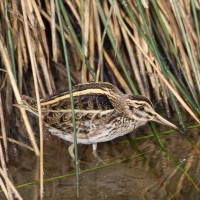Description
The area around Horn kyrka is a quite good site for geese with hundreds of husa polní, husa velká, and berneška velká found most years. Often with lesser amounts of husa běločelá, husta tundrová, husa krátkozobá, and berneška bělolící interspersed. berneška tmavá has been seen. Most geese are found by Rien (marked with a star on the map) in late Febuary and March.
During the spring Riens water overflow and large amounts of open water form. When this happens large amounts of kachna divoká (at most 200), and čírka obecná (at most 150) rest in the area. Among these ducks you can observe smaller amounts of hvízdák eurasijský, kopřivka obecná, hvízdák eurasijský, ostralka štíhlá (uncommon), lžičák pestrý (uncommon), and čírka modrá (rare). Sometimes also some diving ducks. But since water levels vary each spring the amount and variation of ducks at Rien vary accordingly. The wetland at Hornebergs holds permanent water, and usually some dabbling ducks, but not in the same amount. Horn Marsh along with its ponds is also quite good for small amounts of different dabbling ducks.
Diving ducks are most usually found in Åsunden with morčák velký, polák chocholačka, hohol severní being common, while morčák prostřední and morčák malý are uncommon. At Trossbonäs rare diving ducks like turpan černý, and turpan hnědý can be found with luck in April. Even kajka mořská and polák kaholka have been seen there.
In spring if Rien has water in late April waders rest there. vodouš bahenní, vodouš kropenatý (at most 23), čejka chocholatá, and bekasina otavní (at most 100). On the fields kulík zlatý, at Åsunden pisík obecný sing, and in the forests sluka lesní can be found. During heavy autumn rain Rien can gain enough water for waders such as vodouš šedý, jespák bojovný, jespák obecný, koliha velká, kulík písečný, and jespák křivozobý. The fields around Bränna and Västa eneby are pretty good areas for slučka malá in November.
Among predatory birds poštolka obecná, káně lesní, včelojed lesní, káně rousná, orel mořský, krahujec obecný, jestřáb lesní, orlovec říční, ostříž lesní and moták pilich are all common. orel skalní, dřemlík tundrový, sokol stěhovavý, and luňák hnědý are all rare but seen some years. The best places for them are Bränna, Rien, and Åshorva.
Large amounts of passerine birds move along the fields around Horn, therefore large amounts of konopka obecná, linduška luční, konipas luční and other common meadows birds are found along with other rare passerine birds like slavík modráček, kos horský, strnad severní (very rare), sněhule severní, and konopka žlutozobá. The best places for these are Bränna and Rien.
The wetland around Rien and Hornsberg have large amounts of reed and trees which make them excellent places for nightactive birds. All the common bird are found some years with chřástal polní, křepelka polní, rákosník pokřovní, cvrčilka říční, chřástal kropenatý, and cvrčilka zelená. Even chřástal malý has been found.
Details
Access
Horn is located on the southern shores of lake Åsunden. No good parking spots can be found for most of these places but it is often possible to park alongside the road. The area is best explored with bike or car and perhaps not best suited to tourists because there are few facilities for visitors.





